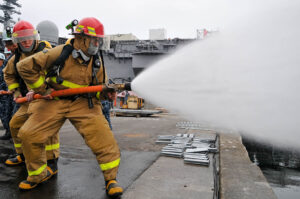Welcome to another in my series on networking at a convention. You can check out parts one and two if you like, but it isn’t necessary to follow today’s conversation.
Today we’re addressing what networking at the convention should be like. It’s a big event and approaching with the wrong attitude can limit your success.
If you’ve ever attended a large, out of town event, you know it can be more than a little overwhelming. Hundreds or thousands of people, hours upon hours of educational opportunities, strange food, strange surroundings — add to that the distance from friends and family and you can end up feeling a little shell-shocked. So, what’s the best way to approach this beast?
Here’s the trick: Unless you have a lot of experience at these things, trying to cope with the convention as a whole is too much. Far better to break it down and deal with smaller pieces. I mean, assuming this is a three-day event, what sort of goal would you set? How many people do you think you could meet during that time? How will you know you’ve succeeded?
Instead of thinking of it as a three-day event, try looking at it as a series of one- to two-hour gatherings. In your local networking, you’ve already undoubtedly attended a variety of mixers, presentations, lunches, coffees, after-hour receptions, dinners, even the occasional breakfast. With that experience in hand, the convention shouldn’t present too great a challenge.
Let’s break down the day into general classes of gatherings.
- Meals. The first, and probably most prevalent will be the meals. In this case, I am referring to those that are formal parts of the convention. These will sometimes have a speaker, but for now let’s deal with those that just involve food.You can treat these just as you would any other mealtime event back home. Connect with the people near you in line (and there will usually be a long line). You can usually get in a long conversation while you wait and if they seem like fun, ask if they would like to sit together. People will often be tremendously grateful for not having to look for a table mate.When seated chat with the others at the table, especially those on either side of you. Again, you can often get in a good fifteen minute conversation over a box lunch.
- Mixers. During the convention you will have numerous unstructured networking opportunities. These can be informal such as the breaks between the formal sessions or more formal settings, such as an evening cocktail reception.In either case, you can treat these pretty much as you would a mixer or the open networking section of a business gathering that you’ve attended before. The only real difference is that you probably don’t know anyone there. Believe it or not, this is a good thing since every person is a new opportunity. Just be friendly and remember to keep your “host” mindset in place.
- Activities. These might be general sessions, break outs, concurrent sessions, classes, keynotes, etc, etc, etc. Basically this is anytime you are in a room focused on some sort of central activity.With these sub-events, you can chat with the people around you up until the time the person at the front of the room calls things to order. You might find out enough that you want to invite them to connect with you over the next break or meal. All good.After the speaker starts speaking, you have one goal: Pay attention. Find something good about the program that you might be able to use or a good question to ask during the Q&A portion (or afterward). Not only will you get the benefit of the content, but being able to tell the speaker or organizer that something they did will be of benefit to your life will go a long way toward creating a good connection with them.
- Exhibit Hall. Most conventions will have an exhibit hall where the sponsors of the event can show their products or services that might help the convention attendees. You can treat this area as a mixer and chat with the other folks who are walking from booth to booth. You can also take the time to chat with the sponsors who are staffing the booths. You might find you either need their service or that you know someone who might. If nothing else, they may be long-time attendees of the convention themselves and could give you some hints and suggestions on how you could best spend your time (or even a good nearby restaurant for dinner).The one caveat with the Exhibit Hall is to remember that these folks have probably had to pay (sometimes quite a bit) for the privilege of presenting their product to you. If the Hall is busy, don’t monopolize their time unless you are truly interested in buying what they have to sell. Save the connections for their downtime.
The convention can be a huge, overwhelming event which, if you aren’t prepared, could paralyze you with its many opportunities. What you don’t want to do is get to the end of it and have nothing more than a pile of notes and handouts that you’ll either eventually throw out or file away on a shelf to gather dust. The true measure of your convention networking success will be the number of new friends you make and the connections you can call on in the future. Break it down. Meeting just one new person per segment of the larger convention will mean your network will grow tremendously in a fairly short amount of time.
Next time we’ll talk about a few final thoughts for a successful convention networking experience.
Photo by Kevin Hastings/U.S. Navy


